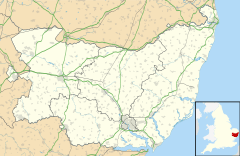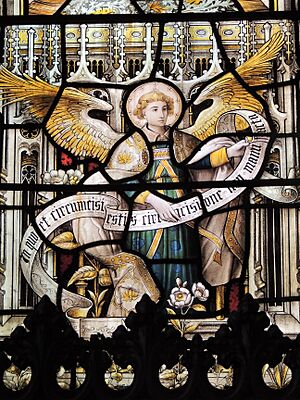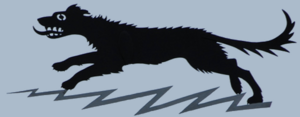Bungay facts for kids
Quick facts for kids Bungay |
|
|---|---|
 Bungay Buttercross |
|
| Area | 11 km2 (4.2 sq mi) |
| Population | 5,127 (2011) |
| • Density | 466/km2 (1,210/sq mi) |
| OS grid reference | TM336898 |
| Civil parish |
|
| District |
|
| Shire county | |
| Region | |
| Country | England |
| Sovereign state | United Kingdom |
| Post town | Bungay |
| Postcode district | NR35 |
| Dialling code | 01986 |
| EU Parliament | East of England |
| UK Parliament |
|
Bungay is a lively market town in Suffolk, England. It's located in the beautiful Waveney Valley, about 5.5 miles (9 km) west of Beccles. The town sits right on the edge of The Broads, a famous network of rivers and lakes. The River Waveney wraps around Bungay like a hug, making it a special place. In 2011, about 5,127 people lived here.
Contents
History of Bungay
The name Bungay might come from an old Anglo-Saxon name, Bunincga-haye. This means "the land belonging to Bonna's tribe." Bonna was a Saxon leader. Bungay was a great place to live because it was high up and protected by the River Waveney and its marshy areas. People have lived here for a very long time, even since Roman times!
Bungay Castle's Story
Bungay Castle is a very old building shown on Bungay's town sign. It was first built by the Normans. Later, a powerful family called the Bigods, who also owned Framlingham Castle, rebuilt it. Inside the castle, you can still see special tunnels called mining galleries. These were dug during a siege in 1174. The idea was to dig under the castle walls to make them fall down!
Churches in Bungay
The Church of St. Mary used to be part of a Benedictine Bungay Priory, a type of monastery. It was started by Gundreda, the wife of Roger de Glanville. A famous Franciscan friar named Thomas Bungay lived here in the 13th century. People even thought he was a magician! He appears in an old play called Friar Bacon and Friar Bungay.
There's also the 11th-century Holy Trinity church, which has a cool round tower. The 19th-century Roman Catholic church of St. Edmund is also nearby.
The Great Fire and Buttercross
In 1688, a huge fire almost destroyed the whole town of Bungay. After the fire, the central Buttercross was built in 1689. This was a special place where local farmers would sell their butter and other farm goods. It was like an outdoor market!
Printing and Railways
Bungay was once very important for making paper and printing books. Joseph Hooper, a rich man from America, started a paper factory here in 1783. Later, Charles Brightly began a printing business in 1795. This business grew and became very well known.
The railway came to Bungay in the 1860s. This made it easier for people and goods to travel. Bungay had its own train station. However, the station closed to passengers in 1953 and for freight in 1964.
Bungay became an "urban district" in 1910, which meant it had its own local government. In 1974, it became part of the Waveney district, and in 2019, it joined the East Suffolk district.
Modern Bungay
Today, Bungay is home to St. Peter's Brewery, which makes drinks at St. Peter's Hall.
In 2008, Bungay became Suffolk's first Transition Town. This is part of a worldwide group of communities that work on local projects. They focus on things like food, transport, and energy. The goal is to help the town become more sustainable and ready for future challenges like climate change.
The Town Reeve
Bungay is unique because it's the only town in the UK that still has a "town reeve." A reeve is like an old-fashioned town leader. The reeve manages the town's trust, and each reeve chooses the next one!
Black Shuck, the Legendary Dog
There's a famous legend about Black Shuck in Bungay. On August 4, 1577, St Mary's Church was hit by lightning during a big thunderstorm. Legend says that a huge black dog, like a ghost dog, appeared! It ran around the church, scaring and hurting people. Then, it suddenly vanished and reappeared in another church 12 miles (19 km) away! This dog is known as Black Shuck, a ghostly dog said to haunt the coasts of Norfolk, Suffolk, and Essex.
The image of the Black Dog is even on Bungay's coat of arms. Many local businesses and events use its name. There's an annual race called The Black Dog Marathon, which starts in Bungay. The town's football team is even nicknamed the "Black Dogs"! The band The Darkness also wrote a song about Black Shuck.
Sport in Bungay
Bungay has its own football club, Bungay Town. They play their home games at the Maltings Meadow Sports Ground.
If you like cycling, the Godric Cycling Club is based in Bungay. They organize many events throughout the year, including weekly club rides.
Famous People from Bungay
Many interesting people have lived in Bungay over the years.
- Thomas Miller and his son William Miller were famous booksellers and publishers.
- The author Elizabeth Bonhôte wrote a gothic romance novel called Bungay Castle. She even owned the real Bungay Castle for a while!
- The Strickland family, who were very famous writers, lived here. One of their daughters was Agnes Strickland, a historian.
- The famous French writer and politician, François-René, vicomte de Chateaubriand, lived in Bungay for a time when he was exiled from France.
- H. Rider Haggard, who wrote adventure novels, was born nearby. He gave a special wooden panel to St. Mary's Church.
- Caroline Haslett, a pioneer in the electrical industry, retired to Bungay.
- More recently, Bernie Ecclestone, who used to run Formula 1 motor racing, grew up in Bungay.
- Artists like Michael Fell and Sargy Mann also lived in the town.
- Poet Luke Wright and children's author James Mayhew live in Bungay today.
- Darts champion Andrew Gilding also lives in Bungay. He won a big tournament called the UK Open in 2023!
Arms
|
See also
 In Spanish: Bungay para niños
In Spanish: Bungay para niños





